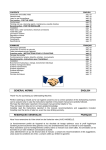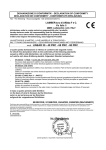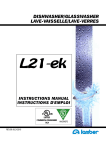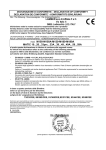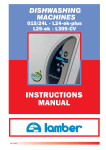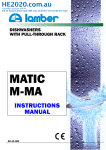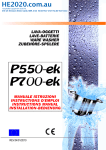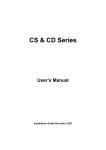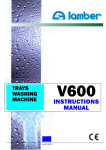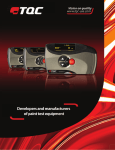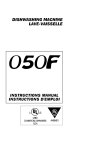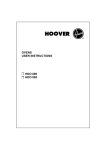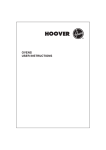Download general norms english remarques generales français
Transcript
CONTENTS Introduction and safety norms General norms Learn to use the appliance ENGLISH pag. 03 pag. 04 pag. 06 First section - FOR THE USER Control panel Working and use, cleansing agents, maintenance, possible troubles pag. 07 pag. 08 pag. 09 Second section - FOR THE INSTALLER Installation Water drain, water connections, electrical connections Tables fitting plan Connections scheme Regulations scheme Wiring diagram Specifications pag. pag. pag. pag. pag. pag. pag. pag. SOMMAIRE Remarque générales Introduction et normes de securité Faites connaissance avec l'appareil Première partie - INSTRUCTIONS POUR L'UTILISATEUR Emploi controles Fonctionnement et emploi, detersifs, entretien, inconvenients Deuxième partie - INSTRUCTIONS POUR L'INSTALLATEUR Installation Branchement hydraulique, vidange, branchement electrique Schema montage des tables Schema branchements Schema regulations Schema electrique Données techniques GENERAL NORMS 17 18 19 23 24 25 26 27 FRANÇAIS pag. 03 pag. 05 pag. 06 pag. 07 pag. 08 pag. 13 pag. 17 pag. 18 pag. 21 pag. 23 pag. 24 pag. 25 pag. 26 pag. 28 ENGLISH Tank You for purchasing our Dishwashing Machine. Perfect washing-up results as far as hygiene concerns and a correct operation of the dishwashing machine can be assured only in case the instructions reported in the present manual are carefully followed. We hope the information reported in the present manual will be helpful to You. They are based on data and our best updated knowledge. Carefully read the Instructions reported in the manual, recommendations and suggestions included. Carefully read the terms of sale too, the ones limiting warranty included. REMARQUES GENERALES FRANÇAIS Nous Vous remercions de Votre choix lors de l'achat de votre LAVE-VAISSELLE. Le fonctionnement parfait de l'appareil et les résultats de lavage optimaux sous le profil hygiénique sanitaire,peuvent seulement être garantis si tous les avertissements dans ce manuel-ci sont respectés. Nous souhaitons que les renseignements contenus dans ce manuel vous soient utiles. Ils sont basés sur les donneés et sur notre meilleure connaissance actuelle. Lisez attentivement ce qui est énancé dans le manuel, y compris les recommandations et les suggestions. Lisez aussi les conditions de vente, y compris celles qui limitent la garantie. INTRODUCTION AND SAFETY NORMS ENGLISH INTRODUCTION - The machine L21 is an Industrial dish-washing machine . The machine is in conformity to the European Norms 89/336/CEE for the radio noises. According to EEC directive nr.23 of 19/02/1973 and the law of actuation nr.791 of 18/10/1987, our appliances are buil-up according to the good technique norms in force in Italy and abroad. Noise level of the machine, less than 70 dB(A). PRELIMINARY OBSERVATION Carefully read the instructions reported in the present user manual, as it gives important indications about safety of installation, operation and maintenance: carefully keep the present manual for further consultations; the illustrations and drawings showing the machine are intended for general reference only and are not necessarily accurate in every particular; the dimensions and characteristics of the machine, given in this Manual, are not to be considered binding and may be changed without prior notice; having removed the packing material, check that all the equipment is present. If there is any doubt, do not use it and contact qualified personnel. The packing elements (plastic bags, nails, etc.) should be kept away from children, because they are dangerous. GENERAL SAFETY REGULATIONS THIS SAFETY CODE HAS BEEN COMPILED IN YOUR INTEREST. Strict adherence to these rules will reduce the risks of injury both to yourself and to others; Personnel working with this machine must adhere strictly to all statutory safety regulations as well as the specific rules listed below. Failure to do so may result in personal inyury and damage to the machine; DO NOT attempt to move, install, set-up or operate this machine until you have read and fully understood this Manual. If doubt persists, ask your supervisor; never leave tools, parts or other loose material on or in the machine; Before switching the equipment the equipment on, make sure that the model plate data conforms to that of the electrical and water distribution network; remember that even with the mains isolator in the “OFF” position, the incoming cables are still live; BEFORE starting machine o cycle, after any maintenance or repair work, make sure all protective are correctly installed; be vigilant at all times, remember that your safety and that of your fellow workers depend on you; when moving or lifting the machine, care must be taken to comply with all the relevant regulations governing such operations; installation should be carried out by qualified personnel according to the manufacturer's instructions. this equipment should be destined to the use which it has been conceived for. Any other application should be considered improper and consequently dangerous; the equipment should only be used by personnel trained for its use; SPECIAL SAFETY REGULATIONS - adjustement and repairs must be carried out only by personnel qualified. Repair carried out by unskilled personnel may be dangerous; perfect washing-up results as far as hygiene concerns and a correct operation of the washing machine can be assured only in case the instructions reported in the present handbook are carefully followed; the machine must be only used by authorized personnel which must comply with sanitary measures; do not leave the machine in environment with temperatures inferior to 0°C; - the machine protection degree is IP21, therefore it should not be washed with direct high pressure jets of water; 2 Learn to use the appliance Faites connaissance avec l'appareil L21 Descl21-UL-3t INSTRUCTIONS FOR THE USER INSTRUCTIONS POUR L'UTILISATEUR CONTROL PANEL EMPLOI CONTROLES L21 Wash time selection Selecteur temps de lavage Main switch Interrupteur général R Drain pumpe Pompe de vidange (grey button) (bouton gris) Main switch lamp Lampe indicatrice de ligne Cycle lamp Lampe indicatrice de cycle Temperature lamp Lampe témperature H Drain pump lamp Lampe pompe de vidange T Dis.1 Wash-Lavage Rinse-Rinçage Wash and Rinse Thermometer Thermomètre témperature de lavage et rinçage OPTIONAL ENGLISH First Section - FOR THE USER WORKING AND USE The dishwashing machine L21 can wash up to 500 plates every hour. The machine protection degree is IP21, therefore it should not be washed with direct high pressure jet water; The objects to be washed should be correctly arranged for a good washing-up result; We suggest to descale dishes, from time to time, in order to remove calcareous and/or starchy sediments by soaking it in suitable solutions suggested by your cleansing agent supplier. If you need to buy new dishes remember the following: Dishes and cups: preference must be given to china or non-porous pottery articles, with smooth surface. Glasses: choose a glass suitable to be washed in dish-washing machines. Surfaces must be smooth and bottoms the least concave possible. OPERATION BEFORE WORKING DBEFORE STARTING SURE THAT : THE WORKING OPERATION BE Lift the hood and put the basket into the dishwasher. E- Choose the washing period cycle between 1 and 2 minutes turning the selector "A" (1:120 seconds - 2:180 seconds - 3:240 seconds). Usually 180 seconds . the cock is open; the filters and the overflow are in their housings; the wash arm and the rinse arm are free to pivot; brightener and washing powder dispenser containers are loaded. F- Close the dishwasher Hood. The green lamp "D" will become lighted and the cycle, including besides the washing, a five seconds stop and the rinsing of fifteen seconds with clean water at 85°÷90°C, will start. At the end of the cycle the lamp "D" will go out. THEN PROCEED: Note: Bear in mind that the opening of the top interrupts the cycle and therefore the machine at any moment. Practically, the opening of the Top as an emergency device. A- Open the Top and put into the tank, possibly over the pump-filter, about 54 gr. of non-lathering detergent in powder. If the machine is provided with an automatic dosing device, control the detergent that is in its container. G- Take away the basket and repeat the operation "F". B- Place the dishes in the basket minding to previously remove all solid waste and fat. Do not overload baskets, dishes must not be placed one upon the other, water must have the way to run on each part of the same. Every 10 cycles add about 40 gr. of detergent. In order to make washing keep on, load another basket and close the Top. The cycle will automatically start again. C- Turn on the wall switch. Let the hood down and turn the main switch “A” on the control panel (fig.1 ) into position 1. At this point the green light “C” will go on and the tank will fill up with water. ACHIEVEMENTS Any deficiency in the washing process is apparent when dirty residuals are visible. Any halos might be caused by an insuffucuent rinsing: in this case, check that the rinsing jets are clean and there is a sufficient pressure in the water distribution network. In the case that residuals are present, check that: N.B. On position “1” the first washing cycle of 120 seconds is automatically selected. 7 • the washing jets are clean • there is detergent • the pump suction filter is clean • the positions of the objects in the rack are correct. DESCALING When hard water is used you can find, inside the machine and also on dishes, calcareous sediments which must be removed both for hygienic and operating reasons by a descaling operation. Operating process and frequency of this intervention are suggested by your cleansing agent supplier who has suitable products, generally containing phosphoric acid. In order to avoid damage to the machine do not increase the quantities and once operations end rinse abundantly. DISHES POSITIONING It is suitable to place dishes, inside the plastic basket with the concave side facing upwards. Place mixed cutlery in a vertical position into the suitable container minding not to cram them and whit handgrips towards the bottom (see draw). SANIFICATION At last each 30 days it would be useful to do this operation which guarantees the complete hygienic conditions of the machine. We suggest to contact your cleansing agent supplier who will give you quantity and name of the most suitable product you can use and that, generally, is an active chloride powder (100-200 ppm). In order to avoid damage to the machine do not increase the quantities and once operations end, rinse abundantly. CLEANSING AGENTS Choice of the suitable cleansing agent is an essential condition if you want to obtain extremely good washing results as concerns hygienic results. It is then important to consider some points. First of all only highly alkaline and chlorine-active antifoam products, especially made for industrial dish-washing machines, must be used and they must be produced by well known reliable Firms. Mean concentration of the cleansing agents in powder must be 1,5÷2,5 g/lt. Mean concentration of liquid cleansing agents nust be 2÷4 g/lt. Doser calibration must be done by a supplier's skilled technician of the cleansing agent. In order to avoid scales and corrosions, put cleansing agent above water level on the nearest area of the sucking pump filter, in this way it will immediately dilute and will not deposit on the tank bottom. DRAIN PUMP INSTRUCTION (only for machines with drain pump) The drain pump automatically starts up at each cycle to discharge the exceeding water coming from the rinsing cycle. In order to completely discharge the tank it is necessary to perform the following operations: 1. Switch the machine main switch "A" off; 2. Remove the overflow from the tank; 3. Soon afterwards press the drain pump pushbutton "R" (the lamp "H" will be turned on). After the water has completely flowed down, press the drain pump pushbutton "R" to switch the pump off. RINSING ADDITIVES To grant a perfect rinsing, a quick drying and to avoid calcareous sediments on glasses and cups you must add a surfactant on water (Brightner). Your cleansing agent supplier's will be able to suggest the most suitable product. Your machine is equipped with a rinse-aid dispenser. Mean concentration used is 0,15 g/lt. WARNING! DO NOT FORGET THE PUSHBUTTON "R" ON "ON" POSITION; THIS CAN CAUSE DAMAGES TO THE PUMP. 8 CLEANING AND MAINTENANCE PRECAUTION INSTRUCTIONS AND DAY MAINTENANCE PREVENTIVE - CLEANING - - - - IMPORTANT : Before carrying-out the cleaning and maintenance operations, disconnect the equipment from the mains power supply: - high temperatures can be reached inside the machine (90°C). ASfter power supply has been removed, wait until the machine has reached the room temperature, before working on it. - the machine protection degree is IP21, therefore it should not be washed with direct high pressure jets of water; - never leave tools, parts or other loose material on or in the machine; - BEFORE starting machine or cycle, after any maintenance or repair work, make sure all protective are correctly installed; - Disconnect the machine with pushbutton "A"; Lift the overflow pipe and let the water drain out of the tank; Wash thoroughly the tank and the filters housing to remove all impurities; Take the filters and clean it under running water; Re-assemble the overflow pipe and the filters in their housings; Check and clean the washing and the rinsing jets; Clean the outer surface of the machine by using a wet sponge; don't use water jets because, beside being dangerous they could damage the electrical parts; don't use abrasive detergents; When the machine is to remain idle for a long time, drain all the water from the boiler (the drain plug is located on the lower side of the boiler) and from the electropump. Also leave the wash tank open. NEVER WASH THE EXTERNAL PART THE MACHINE WITH A WATER JET OF POSSIBLE TROUBLES - CAUSES - SOLUTIONS PROBLEMS CAUSES SOLUTIONS The machine doesn't catch Main switch is switched off; Turn ON the main switch; The water doesn't go in Water cock closed; Open water cock; The Overflow is not in its place; Reassemble the Overflow in its place; Wrong detergent or dosage insufficient; Use anti-foam detergent in the right dosage and never with cold water; Low temperature in the tank; Wait untill the water gets hot; Dirt wash filter; Clean filter; Rinsing nozzles blocked; Unscrew and clean nozzles under running water; Hydraulic pressure lower than 1 bar - 100 kPa; Wait till the pressure is on or buy a booster pump; Insufficient Washing Insufficient Rinsing CAUTION! FOR ANY OTHER TROUBLE, CALL SERVICE 9 USEFUL HINTS OF STAINLESS STEEL MAINTENANCE Stainless steel is so called because it is not affected by oxidation,this is due to a thin molecular layer of oxide on the surface which protects againts further oxidation. There are, howevwr, substances which can modify or destroy this layer,giving rise to corrosion:besides preventing the protective film of oxide from reforming,these substances corrode the stainless steel itself and can cause irreparable damage. It is therefore necessary to prevent this by choosing correct cleaning products and by complying with the following simple recommendations:never forget that when using these appliances,the first and fundamental rule is to guarantee that the cleaning products are both non-toxic and hygienic. Before using any detergent to clean either the stainless steel or the immediate and sorrounding floor area, always ask your supplier for the most suitable product which does not cause corrosion on the steel itself; the onset of rust is most commonly caused by the use of unsuitable cleaning materials (strongly acid chlorate based detergents) or on inadequate maintenance. Our appliances are made of stainless steel AISI 304 (18/10 type) for exterior panelling,upper tops,tanks etc. Comply with the following instructions when cleaning and servicing parts in stainless steel. Ordinary daily maintenance Carefully and frequently clean the surfaces using a damp cloth; use soap and water or normal detergents,so long as these do not contain abrasives or chlorine based substances such as sodium hypochlorite (bleech),hydrochloric acid or other such solutions:These products quickly and irreparably corrode stainless steel. When cleaning floors underneath or near the appliances, never use the above mentioned products as vapours or splashes could subject the steel to similar destructive effects. Only ever rub in the direction of the satining, then thoroughly rinse with clean water and carefully dry. Rust : water supply pipes, inevitably convey particles of rust dissolved in the water especially in new installation plants or when taps are opened after a period of inactivity. These iron deposits must not be allowed to remain on the stainless steel since they produce rust by contamination. Use suitable products to remove any rust marks,from companies which produce detergents for industrial use. After application, thoroughly rinse with clean water, neutralizing the action of the product with an alkaline detergent normally used to clean such appliances or with another specific product. DO NOT USE METAL MATS TO CLEAN THE STAINLESS STEEL 10 INSTRUCTIONS FOR THE INSTALLER The following instructions are addressed to a qualified personnel, the only one authorised to carry-out checks and repair, if any. The Manufacturer declines any responsibility in the case of interventions made by a non qualified personnel. INSTRUCTIONS POUR L'INSTALLATEUR Les instructions suivantes sont adressées à un personnel qualifié, qui est le seul autorisé à effectuer les vérifications et les réparations éventuelles. Le constructeur décline toute responsabilité en cas d'interventions effectuées par du personnel non qualifié. 15 INSTALLATION INSTALLATION L21 2000 700 1310 700 600 700 620 530 A Maximum height for drain to wall Hauteur maximale pour vidange à mur E Water inlet Electrovanne chargement L Electric input Branchement eléctrique S Drain Evacuation Eau 210 230 Liner Lineaire Rev.281101 L 530 Corner version Version d'angle 208/1 60Hz 765 E S 1455 700 210 230 755 L 395 520 765 510 E S A 1360 720 620 150 200 400 620 395 520 180 A E 150 200 E 400 L L 620 870 1435 1815 1435 380 870 380 1815 600 ENGLISH Second Section - FOR THE INSTALLER During installation, carry-out a good machine levelling, which is a prerequisite for a correct operation thereof. The Manufacturer cannot assume any responsability for any damage to persons or property deriving from the non-observance of the above-specified norms. For correct installation see draw page 18. ELECTRICAL CONNECTION Before connecting the machine, check to make sure the voltage outlet of the mains is the same as the voltage specified on the data plate of the machine. The electrical safety of this equipment is only assured if it is connected as follows. It is necessary to connect the equipment to an effective ground installation, as specified by the electrical safety regulations in force. Chack that this basic requirement is complied with and, in case of doubt, ask for a careful check of the installation by a qualified personal. A main switch must be installed between the mains and the machine. This safety measure also requires that the minimum distance between the switch contacts is at least 3 mm and the disconnection on all poles according to EN 60204 (VDE 113). In addition, the equipment shall be part of an equipotential system, the effectiveness of which should be checked according to the regulations in force. Fuses on the main switch must be 16 A . The mains must be wired to be able to handle the current drawn by the machine.The system must also be provided with a proper ground lead in accordance with the existings norms. The electric cable must be of the following type H07RN-F. The connection should be made at the screw marked by the respective label located on the equipment back side ( THE MACHINE SHALL BE CONNECTED WITH AN EFFECTIVE GROUND CLAMP. Supply circuit information : Minimum supply circuit ampacity, rating of overcurrent protective device : The manufacturer declines any responsibility for any damages caused by lack of an effective ground installation. Supply Circuit Rating of Conductor Ampacity, A Overcurrent Device, A 34 ). 40 17 WATER CONNECTIONS WATER DRAIN Carefully comply with any national or regional regulations in force. According to the dimensions of the drawing; water drain and feeding pipe should have the same diameter of the water inlet of the machine. Water installation must have the following characteristics: It must be furnished with a siphon and have a right slope. Temperature: 55°C The machine is provided with a flexible pipe for the connection with the water-work. Make sure there are no throttlings along the pipe. Dynamic Pressure : 20 ± 5 psi Carefully comply with any national or regional regulations in force. If the dynamic pressure is lower than specified on the data plate of the machine, it is advisable to install a Pump for pressure increase. If the dynamic pressure is higher than 4 bar, it is advisable to install a pressure reduction. Hardness: between 7,2 and 12,5 °French. If the hardness values are higher than those mentioned above, it is advisable to install a water-softener. TEMPERATURES Water temperature >74°C Rinse temperature 82°÷90°C DO NOT TAMPER WITH THE THERMOSTAT CALIBRATION 18 REGULATION SCHEME SCHEMA REGULATION L21 Rinse-aid dispense Doseur de produit pour rinçage B Rinse-aid inlet Entrée du produit de rinçage A Wash and rinse thermostat Thermostat Lavage et rinçage A- Wash and rinse thermostat Thermostat Lavage et rinçage Rinse thermostat Thermostat rinçage Rinse-aid dispenser Doseur de proudit pour rinçage - To increase the detergent turn Anti-CW the regulation screw - Tourner la vis de regulation en sens Anti-horaire pour augmenter la dose du produit Wash thermostat Thermostat Lavage + + Scdosa-L20














